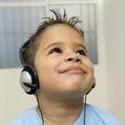|
| |
The Brain, Developmental
Gains and Auditory Integration Training
Contact Us
Complete
On-line AIT Checklist
by Rosalie
Seymour, SLP/A, Berard AIT Practitioner
We
learn so much about normal development by studying developmental differences,
and difficulties. It is when we watch a child struggling to speak
that we realize what a complex behavior the act of speech is, and how
marvelously we are made to have acquired such a skill so easily when we
were young, and what a precious gift from God it is! When we see a
teenager
of 17 years still unable to read despite years of remediation, we may
marvel at the intricacies of the brain’s development that allows some
preschoolers to read with ease!
When
development slows up, or goes wrong somewhere, a group of concerned adults
(this may include doctors, pediatricians, neurologists, psychologists,
educators, remediators and therapists) may gather to understand the factors
involved, and to try and “solve” the problem, to get properly back on
track.
Parents,
especially, have been the ones who have sought for understanding of these
factors. Parents are usually the only members of the “team” of concerned
adults who see the child’s behavior all the way through night and day;
- who notice a collection of puzzling differences in these children that
extend far beyond public behavior and scholastic success (or the lack
of it!).
Social
Skills Immaturity
One
such common factor is that of poor pragmatic skills: the social skills
aspect of communication. These children almost without fail seem
to have difficulty with social tasks that come so easily to others:- turn-taking,
give-and-take, topic control or keeping to the topic, how to repair a
misunderstanding or miscommunication ….. As children develop, these
skills are employed with increasing ease, but these are tasks that never
reach a competence level in the child with SLD, autism,
or a language deficit.
This
lack is what causes these children to be labeled “immature” in reports.
Usually, a child will make rapid progress in this area. They learn
socially acceptable ways. The SLD or language – delayed child commonly
does not acquire those skills as expected. He seems to lag behind
socially.
Impulsivity
This
is not the only area of immaturity seen. These children often are
reported to be vague, unfocused, “dreamy”, and find it hard to concentrate
for long enough on one task for their age level. They are
seen to be impulsive, hasty, too quick off the mark, - sometimes to the
point of rudeness. These are aspects of neurological maturity that
develop with age. These children lag behind.
As
for the child with autism,
one of the distinguishing marks of this disorder is a severe lack of social
skills. This lack of even the most basic social skills has led experts
and parents to conclude that these children lack any interest in social
interaction. This is frequently a false assumption . Many
people with autism, who
later were able to tell their own story, have told how they longed to
part of society just like anyone else, but they were unable to “crack
the secret code” of how to relate. (Temple Grandin, Donna Williams,
Jim Sinclair).
The
Hearing Factor
Another
common factor, is that of hearing problems. An informal survey reveals
that around 90% of children with Specific Learning Disability (SLD) have
a history of repeated ear infection, upper respiratory infections, and
allergies, that affected the ears. It has also been seen that about
90% of children with autism have had this same kind of medical history.
Medical
opinion is divided as to the significance of repeated ear infections in
the histories of these children. This is largely due to the way
the terms are defined when doing research on this topic. We need
to understand the basic terms, especially “hearing within normal limits”.
What
is “Normal” Hearing?
When
an Audiologist tests hearing, she/he is looking for deafness, a hearing
loss. The degree of hearing loss is given in percentages, or in
decibels (dB). Normal hearing is between 0 to 25 dB, by usual standards.
A child or adult can have lost up to 25 dB of sound and still be classed
as “hearing within normal limits”.
It
must be understood that “hearing within normal limits” does not necessarily
mean good hearing at all. When you block out sound by putting your
fingers in your ears, you may be losing as little as 15 dB only.
You know how this sounds, though – one can have blocked out quite a lot
of sound, i.e. lost quite a bit of auditory information.
When
an adult loses this much sound, it doesn’t matter too much, because they
have a store of knowledge and can “fill in the blanks”. This is
not the same for a child, especially a young child. They are still
learning about words, sounds, what things mean, etc,.
A
child is still learning about his auditory environment. He must
still make connections, learn to listen, and take in knowledge that is
best done via the ears, and for this he must have an intact auditory system.
He needs a good mechanism that will deliver all the auditory information
for processing; - clearly, without distortions.
What
About Auditory Processing Disorders (APD or CAPD)?
It
is standard practice to test the hearing of the speech- or learning-handicapped
child, to see if there is some hearing loss (i.e. greater than 25 dB).
In most cases, the hearing is said to be “within normal limits”.
This result was taken to mean hearing is good. Not so!
We
must also take into consideration that the child may have a Central
Auditory Processing Disorder,(CAPD). The existence of
a CAPD can be expected when there are a number of problem behaviors in
the area of listening:
-
the
child has a slow response to what he hears
-
gets
instructions wrong
-
forgets
what he’s been told
-
has
trouble spelling (phonics)
-
and
learns poorly through the auditory channel.
It
is as if the ear receives the auditory information, but some interference
disturbs the proper, harmonious decoding process that should lead to understanding.
As a result, comprehension of the message may be poor.
If
the hearing system does not perform its task efficiently, if the message
is received with distortions in it, the meaning will be lost in places,
and the child will have to work very hard to “fill in the gaps”.
-
After
a while, the child tires and loses concentration
-
he
may give up and his attention wanders
-
perhaps
he is still trying to process the question that was asked, instead
of being ready to come up with the answer!
-
In
a classroom such a child will be accused of daydreaming. The
child has no idea that things sound differently to him than to others
– all he sees is that everyone else is coping better than he does,
and gets into less trouble than he does.
-
Discouragement
begins to grow.
-
Added
together with frustration, this leads to bad behavior, and he either
becomes disruptive in class, or withdraws (disengages).
Auditory Processing Disorders (APD
or CAPD) Can Cause Developmental Problems
A
difficulty with auditory processing may occur anywhere along the auditory
pathway to the brain, even in the way the ear prepares itself to receive
the sound; i.e. attention to the signal, or in the way the nerve cells
respond to a sound signal. The system may be so dysfunctional that
even a soft sound may elicit a strong response – a sound that doesn’t
bother anyone may cause this person acute discomfort. This is called
hyperacusis.
Research
has shown that about 40% of autistic
people have hyperacusis, but it likely that the percentage
is much higher than that. It is also found that about 40% of learning
disabled people suffer from this condition.
Treatment
of Auditory Processing Disorders APD is Auditory Integration Training
- Berard AIT
Until
lately, there hasn’t been much that could be done about this condition
of Central
Auditory Processing Disorders (CAPD) directly. The
treatments have been supportive, e.g. teach the child to use a diary,
check that he’s heard you correctly. Any textbook about learning
problems will have many chapters on what to do for visual problems, but
very little about how to help children with CAPD.
Lately,
a new option has come to the fore. A French Ear-Nose- and- Throat
specialist, Dr. Guy Berard, developed
a method of using electronically modulated music to bring the hearing
mechanism to more effective function. By doing this, one can remove
the obstacle to developing good auditory processing.
This
method is known as Auditory Integration
Training. It was developed by him to treat his own progressive
hearing loss. His search for a treatment for his condition led him
to develop the AUDIOKINETRON. This electronic device distorts the
music that is played through it, with rapid and random switching from
low sounds to high sounds. These sounds are played to the listener
over headphones for 20 sessions each lasting half an hour. At the
end of this time, the hearing mechanism has adjusted itself, and has become
an efficient transmitter of auditory information.
Dr.
Guy Berard likens the effect of this electronic modulation of the
music to a type of physical therapy of the hearing mechanism, a sort of
aerobic work-out. It starts out at a medium loudness level, like
a moderately-paced exercise session, and then increases in intensity until
one reaches the optimum level of intensity. This level is maintained
then for the remainder of the sessions.
Signs
of Change During and After Auditory Integration Training
-
During
Auditory Integration Training,
there are sometimes changes in behavior that can be attributed to
fatigue and the person’s reaction to changes in their “perceptual
field”.
-
fatigue
is common
-
sometimes
headaches occur
-
or
a change in sleeping or eating patterns
-
sometimes
there is a spurt of challenging behaviors
-
occasionally
the child may revert to earlier behaviors
-
these
changes are of a temporary nature, and disappear shortly after the
end of the course of treatment.
The
improvement in the auditory processing mechanism continues to impact on
the child’s behavior and learning over the next three months or so, and
one commonly sees a slow, but sometimes dramatic, improvement that is
sustained.
The
checklists that have been used to chart the behavior improvements are:
-
the
Connors Scale
-
Fischer’s
Auditory Problems Checklist
-
and
the Aberrant Behavior Checklist, and a recent addition
-
the
ATEC (Autism Treatment Evaluation Checklist)
-
Various
neurological measures have also been used, e.g. EEG’s, brainstem measures,
and PET scans, as well as urinary peptide analyses.
-
Parent
and professional reports are favorable, with no negative effects being
reported from the treatment.
A
listening test is done at the beginning, middle, and end of training.
The final graph usually shows some changes, towards a more even graph,
with less extreme peaks and valleys evident. Occasionally there
is a minor improvement in hearing threshold.
Georgiana
Stehli’s Case: Auditory Integration Training for Autism
In
Dr. Berard’s case, his
progressive hearing loss was prevented from worsening, and slightly improved,
and his tinnitus disappeared. This effect has remained over 40 years,
with occasional repeats of Auditory
Integration Training. He found the training was also of benefit
to children and adults with learning disorders/dyslexia. Some
autistic children with
dyslexia were brought to him for help, and so it was that Georgiana Stehli,
age 11, was brought to him for help. Thought to be retarded, diagnosed
autistic and dyslexic
and psychotic (Bellevue, USA), Georgie’s extreme auditory sensitivity
underwent such a profound change during Berard
AIT, that she has recovered from autism.
She graduated from college with a magna cum laude, speaks five languages,
and is married and the mother of a lovely girl.
Is
Auditory Integration Training a "Cure"?
Not
all results are this dramatic, but many people have been enabled to live
less restricted lives, move out of special education, improve social responsiveness,
and often become more confident people after Auditory
Integration Training. Berard
AIT
is not a cure, and practitioners of this intervention have not
hailed it as one.
Where
this term has been used, is in the popular media, as an attention-getting
device. This word has also been thrown at practitioners of
AIT by various professionals in an attempt to discount the value of
Berard method of AIT.
Those with better insight and information regarding Berard
AIT understand its value as another part of the tool kit to get the
job done. What is so exciting about Berard
AIT is that it is a valuable tool that reaches deeper than we’ve
been able to go thus far. For the moment! It may be that soon
someone else discovers an even better tool. It is hoped so!
These
changes in children with autism,
and learning disabilities after
AIT, have challenged previously-held beliefs about these conditions.
It does seem that the ear is a significant part of these disorders, and
that Berard
AIT may be a helpful part of the solution. There is indeed something
that can be done about auditory processing disorders, and it seems it
can be done in ten hours of stimulation.
It
seems that Berard
AIT lays a good foundation for further therapies in problems like
speech and language disorders, autism,
dyslexia, and a variety of problems of neurological origin.
Auditory training has always been the logical starting point in speech
therapy, and remedial education, and
AIT seems to be a powerful new intervention to fit in this slot.
| |
|






